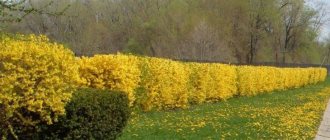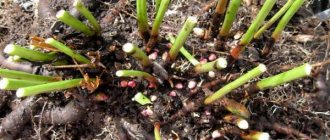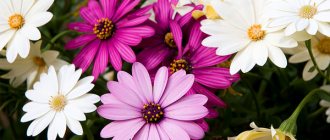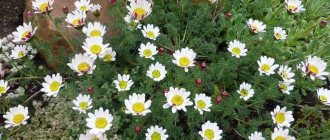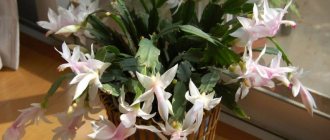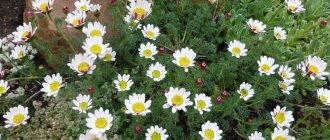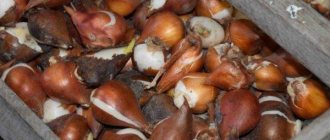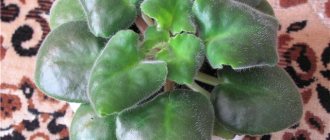Chamomile is a fairly delicate and unpretentious plant. It is found in fields, meadows, and steppes and belongs to the herbaceous representatives of the Asteraceae family. In total, ordinary people know more than 70 varieties of colors. In addition to white, there are pink, yellow, and lilac flowers. At the same time, many people are interested in when daisies bloom and how long this period lasts.
The flowering of daisies directly depends on their variety.
Main varieties of flowers
The flowering of daisies depends on their species. The main varieties include those listed below.
Alaska
This plant has large flowers and reaches a height of 90 cm. The inflorescences grow up to 12 cm in diameter.
Plants are usually planted in autumn. At the same time, buds appear on them the following summer.
The culture is considered very unpretentious: it can easily withstand drought and loves sunlight.
Princess
This sun-loving perennial has lush white inflorescences. It does not exceed 35 cm in height. At the same time, the opened buds have a diameter of no more than 10 cm.
Chamomile Princess loves moist soil. It is characterized by a long flowering period. When do daisies appear? Flowering begins in July. The plant may stop blooming only in mid-October.
Daisy Princess
North Star
This crop is very popular among gardeners. It is very drought tolerant and has beautiful white flowers.
The length of the stem is 60-70 cm. It is not recommended to place seedlings in shady parts of the garden. Plants can be planted in spring or autumn. In this case, flowering will begin only in the second year.
Nivyanyk
This is a fairly large plant, reaching 90 cm in height. In this case, the opened buds exceed 15 cm in diameter.
The plant is considered frost-resistant and can easily withstand drought. However, abundant watering will help you get more spectacular flowering.
The main types of cornflower include:
- common or meadow chamomile - flowering begins in mid-May and continues until the end of July;
- magnificent - is a bush plant with large white inflorescences, the diameter of which reaches 10-15 cm;
- largest - the plant has branched shoots and baskets with a diameter of 12-15 cm;
- Kuril - widespread and has a stem 20 cm long;
- hybrid - represents the work of breeders and is characterized by high strength, stability and longevity.
Nivyanik is a crop with fairly large flowers.
Decoration of the site
Daisies look very attractive in flowerbeds and flower beds, so they are often used to decorate various flower plantings in parks, alleys, etc. The cityscapes of almost none of the megacities are complete without flower beds with your favorite flowers.
Undemanding in terms of breeding and growing conditions, these herbaceous plants are very loved by flower growers for their unpretentiousness. They make almost no demands on the soil in which they grow, but love a large open space with plenty of light. If squeezed in close quarters and with a lack of sunlight in shady places, they will begin to develop, but the flowers will be very small and pale. Chamomile loves space and freedom.
The seedlings of these flowers are very well tolerated and take root in a new place, but the seedlings themselves have to be brought to readiness in greenhouse conditions, since the plants do not withstand frost very well.
When planting chamomile, observe the following interval between bushes:
- for low plants – 20 cm;
- for medium-sized species – 25 cm;
- for tall species – 30 cm.
To breed chamomile for the purpose of creating bouquet arrangements, the planting scheme in ridges is most often used. In decorating urban exteriors, their scope of use is usually to decorate curb lines.
Chamomiles require virtually no personal care, but it is still recommended to remove faded buds from time to time to extend the period of active flowering.
Colored daisies: types and description
Thanks to advances in breeding, today there are more than 100 colorful species of daisies.
The most popular varieties include:
- Pyrethrum pink - has many types that differ in the richness of the shades of the petals. The crop is also called Persian chamomile. It does not tolerate excess or deficiency of moisture. The plant can be grown in the shade. It is characterized by a long flowering period. It continues all summer.
- Red pyrethrum - resembles pink. At the same time, large bright red inflorescences are considered a feature of the culture.
- Yellow Doronicum is a perennial plant that has bright yellow petals. The flowering of the crop begins quite early. It blooms in mid-March. This month the plant reaches a height of 70 cm. The crop multiplies quickly and does not require special care. It easily withstands frosts and is considered undemanding in terms of lighting.
- Dark blue chamomile is an annual that grows up to 60 cm in height. The culture is best known for its use in cosmetology and medicine for the production of essential oils.
- Orange chamomile - also called orange chamomile. This is a perennial herbaceous plant that has narrow bright orange petals. This variety loves the sun and grows quickly.
Pyrethrum pink has beautiful bright inflorescences.
Biological rhythms of plants
All processes that occur in plants are rhythmic in nature. Chamomile petals and leaves are sensitive to natural changes. The daily rhythm of a flower depends on the location of the moon and sun.
According to numerous studies, 13 biological processes occur in chamomile, which are repeated from time to time, forming a single rhythmic system.
Flowers open and close at specific intervals. They also depend on seasonal cycles and daylight hours.
Chamomile petals begin to open at 6 am. In this case, the plant blooms during the day. This interesting phenomenon is called photoperiodism. However, it is important to focus on the geographical location of the site, the time of sunrise and sunset. Therefore, the algorithm directly depends on the area.
If chamomile is moved to a dark room, periodic movements will persist for 9-10 days. However, then her tissues will experience a lack of nutrition.
The biological rhythm of a plant can change depending on the climate. This must be taken into account when growing crops.
Flowering of daisies ordered by time
Seedling method of growing garden perennial chamomile
It is carried out in the spring by alternately planting young seedlings in separate holes located at a distance of 30 cm from each other. When using this planting method, you should beware of frosts, which can lead to the death of a fragile plant with its fragile root system. Until a stable average daily temperature is established, covering materials will help the summer resident.
When they bloom depending on the region
Chamomile is a typical summer flower. Therefore, answering the question of when exactly daisies bloom, it should be noted that in most territories this happens in the last days of May.
In the southern regions of Ukraine and Kazakhstan, daisies can bloom as early as April. The same periods are typical for the foothill regions of the Caucasus and Crimea.
Answering the question when is the daisy season in the Mediterranean, it must be said that it comes even earlier. For example, on the islands of the Aegean Sea, in the southern regions of Greece and Italy, thickets of culture appear already at the end of February. Here, the growing season and fruiting of some plants occur even in winter.
As you move north, flowering time shifts closer to summer. When do daisies bloom at the latitude of Kyiv and Voronezh? This happens in mid-May. At the same time, in the Moscow region flowers bloom at the beginning of June, and in the northern regions at the end.
The timing of flowering directly depends on the climate of the region.
Flowering period and timing
Many people are interested in when daisies bloom. The specific time directly depends on the variety and variety of crop.
- During flowering, the bushes first bloom with peduncles located on the central axis.
- Then flowers appear on the side branches. Flowering of each of them lasts from 7 to 10 days.
- However, under natural conditions, there are cases of flowering of the basket within 3 weeks.
Uneven development of flowers and shoots increases flowering time to 1-2 calendar months. As a consequence, the periods of seed ripening are also extended in the time interval.
Culture is valued by many gardeners and landscape designers. This is due to its brightness and decorative properties.
What month do they start?
Pharmacy chamomile begins to bloom 30-40 days after the sprouts appear. This usually happens in the first half of June. Moreover, in July it is already allowed to collect valuable heads. The flowering of the crop lasts all summer. In warm southern regions, the flower blooms already in May.
Other varieties of daisies bloom around the same time - in June or July.
If ordinary people are interested in when do field daisies fade? This usually happens in the first half of September. Therefore, the question of whether daisies grow in August should be answered in the affirmative.
The pharmaceutical variety begins to bloom 30-40 days after the sprouts appear.
Caring for garden perennial daisies in the garden
What does a gardener need to know and do and how to properly care for daisies in the garden?
Not only newly planted seedlings, but also early seedlings in open ground need frequent watering. Initially, the young plant is watered very often, but when the root system takes root well and becomes stronger, it is watered less frequently, 2 times a week. After watering, constantly loosen the top layer of fertile soil, do not forget about weeding and removing weeds. Several times a season, the soil near the plant is mulched with a thin layer of peat, 2-3 cm thick.
There is an unspoken rule for growing daisies - the more often the bushes are watered and fertilized, the better and more abundantly they bloom.
Garden chamomile does not tolerate acidic soils well, so it is imperative to add slaked lime or dolomite flour to soil with an elevated pH balance. In addition, for proper nutrition of plants, you need to regularly add compost, peat and humus.
You can feed chamomile with nitrophoska. This is done in the spring, during the active growing season. The fertilizer is diluted in water at the rate of 2 tablespoons per 10 liters of water.
The largest flower among chamomile varieties - But its caps can also be made as large as possible by introducing timely fertilizing. Nivyaniki are very responsive to organic fertilizers. In addition, in the spring during the growing season, large-flowered varieties need to be fed with ammonium nitrate. The fertilizer is not embedded in the soil, but is scattered between the rows with an approximate calculation of 20g per 1m². No special watering is required after this.
You can re-apply urea during the period when the plant begins to form buds. However, this is done only if the foliage is pale in color. To avoid acidifying the soil with mineral fertilizers, add some nitrogen-containing substances. To do this, you can use both chemical mixtures and weak solutions of mullein or bird droppings.
To ensure abundant flowering from year to year, the bush needs to be rejuvenated every 4-5 years.
To do this, partial pruning of the root system is performed on one side of the plant. After three years, the same is done with the remaining part of the flower. In autumn, dried chamomile is cut before frost sets in. It needs to be covered for the winter.
Nielweed grows in one place for no more than 7 years. It requires periodic replanting. Strong growth harms the plant; it needs to be rejuvenated, in particular, to separate the bushes. Hybrid varieties need to be divided every three years.
Flower collection and use
The flowering period of daisies lasts from May to autumn. Therefore, it is possible to collect inflorescences over such a long period approximately 6 times. It is recommended to dry them in the shade or in the fresh air.
It is advisable to keep the resulting raw materials in textile bags, bags or paper boxes. This should be done for a maximum of 1 year.
Pharmaceutical chamomile can be used in its pure form or mixed with other herbal infusions. They should be used for diseases of the digestive organs - intestinal disorders, ulcerative defects, gastritis.
The plant has mild sedative and analgesic properties. Therefore, it can be put into tea and consumed when overworked, sleep disturbances and overexertion.
The flowers of the plant can be used to make tea.
